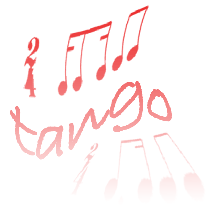

ALWAYS TIME FOR SIGNATURES
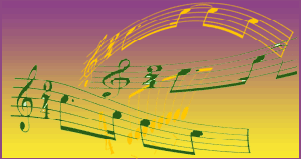
The rhythm of tango is often notated with a 2/4 time signature, but it can also be notated in 4/4, or 4/8. The top number of the time signature is important to the dancer because it tells the dancer how many beats/counts there are in a measure, thus pointing out the "down beat" which occurs
on the first count of the measure, and any accents or irregularities that may exist later in the measure.
On the other hand, the bottom number is not important to the dancer. Rather, known to musicians as the "unit of beat," the bottom number is vital to performing musicians because it determines what type of note will receive one count.
So, with this in mind, in tango the dancer counts: 1-2-3-4, or 1-2, 1-2. However, tango rhythm is more complicated than a straight-forward count. Because of this, it’s extremely important for the dancer to listen to a variety of tango in order to feel the variations in tango tempo known in the music world as rubato.
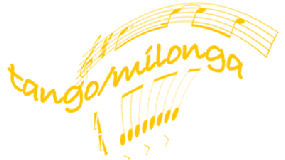
Listen carefully for variations in tempo. With practice, you’ll begin to listen for rubato, rather than assuming that there’s a regular beat in the music, and you’ll be able to speed up or slow down your clapping with the performing musicians.
The rhythm of the Argentine vals is more predictable that that of the tango.
Vals rhythm is usually notated in a 3/4 time signature. This means that every measure will have three counts. It may seem a bit more complicated than this to the dancer because the first count of every measure is the down or strong beat, followed by counts 2 and 3. However, the first count is the only count that is counted by the dancer.
To add to this confusion, since the first count of each measure is the only one that is counted, you might hear a teacher say "This is a vals – 1, 2, 3, 4." Literally, the teacher is thinking "1, 2, 3; 2, 2, 3; 3, 2, 3; 4, 2, 3.” The bolded numbers simply indicate the first count in a measure within a grouping of four measures.
In addition, there can be rhythmic complexities within each measure of vals. In reality, a dancer would rarely step on only the first count of each measure; this would make the dance seem heavy. Instead, there are many ways in which a 3-count measure can be divided ¯ i.e., a step taken: on each of the three counts of the measure; on the first and third counts; on the first and second counts (not as common); and on the first count and the second half of the second and third counts (very common). This sounds difficult, but it is a common rhythmic pattern in vals, and easy to recognize with a little practice.
Lastly, the tempo of vals is comparatively regular, meaning that the speed at which each measure passes will be almost the same. Also, because each 3-count measure goes by quickly, there is little discernable rubato within the measure; any rubato that occurs in vals usually takes more than one measure to complete.
This is good news for dancers, who can concentrate on constructing measures with a variety of self-contained rhythms rather than trying to keep pace with music that is slowing down and speeding up.
The milonga, the third and final variety, has perhaps the easiest rhythm to understand of the three types of Argentine Tango music. To begin, the tempo is comparatively steady, and, for the most part, the dancer dances on every count of the music.
Since the time signature is usually 2/4 or 4/4, the dancer will dance: 1, 2, 1, 2, or 1, 2, 3, 4; 1, 2, 3, 4. In spite of the underlying rhythms in milonga, for the most part, the dancer will step on the first and second counts of the measure (first, second, third, and fourth if the rhythm is 4/4).
The primary difficulty of this dance is its fast tempo, leaving the dancer little time to think about extravagant figures. Instead, he or she concentrates on staying with the music's regular beat, taking small steps, and adding whatever flourishes are possible within milonga's limited amount of time per measure. Again, listening practice along with foot tapping will quickly aid the listener in an understanding of milonga's rhythm.
Tango rhythm need not be a mystery. In fact, with effort, the rhythm of this Argentine dance and song can be understood and appreciated by dancers and listeners alike.
However, as with any subject studied that we intend to further explore, our learning will be facilitated by a detailed focus on terminology that is used to discuss tango, and by listening intently to many of the same recordings of the three types of tango over and over again.
Pursue this and you will find that you not only hear tango music anew, but you will also understand its rhythmic intricacies, and consequently become more aware of what makes a tango a tango.
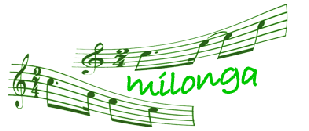

Advertise in:
AS WE INAUGURATE
TANGO LIFE & NEWS
TAKE ADVANTAGE OF OUR EXCLUSIVE
ONE-TIME OFFER TO PLACE YOUR AD HERE
FREE DURING NOVEMBER!
ADVERTISERS, DON’T MISS THIS CHANCE TO FEATURE
YOUR BUSINESS IN PREMIUM WEB SPACE
THAT WILL BE SEEN BY A GLOBAL AUDIENCE!
FOR DETAILS.
312.287.8406
AS A SPECIAL INTRODUCTORY BONUS, YOU’LL ALSO RECEIVE A DISCOUNT ON ADS PLACED THROUGH JANUARY 6, 2011.
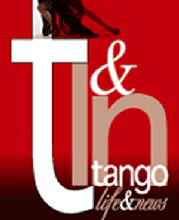
DEMYSTIFYING THE RHYTHMS OF TANGO
THE DANCE AND SONG OF ARGENTINA
CONTINUED
